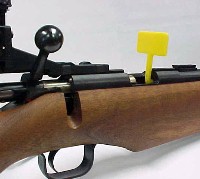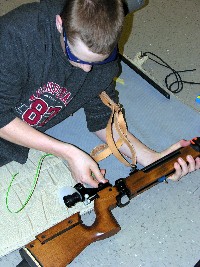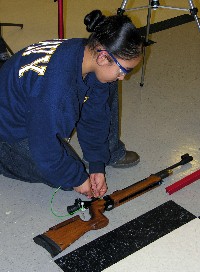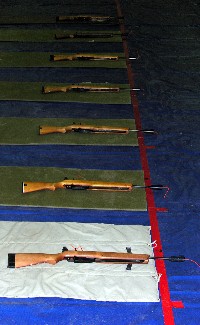The use of Open Bolt Indicators (OBIs) has been mandatory for highpower rifle shooters for several years. These devices, which are now called Empty Chamber Indicators (ECIs), are inserted into rifle actions and chambers when rifles are brought to the firing line and remain in rifles at all times except during preparation and firing periods. OBIs or ECIs have a probe that fits into the rifle chamber to verify that the chamber is empty as well as a yellow or bright-colored flag that projects out of the action to verify to range officers and other shooters that the rifle is unloaded with its action open.
 |
| A Kimber M82 smallbore rifle with an OBI inserted. These safety indicators clearly and vividly demonstrate that guns are unloaded with actions open.
|
These “safety indicators” are now enthusiastically accepted by highpower rifle shooters and their use us required in highpower matches. The CMP, NRA and USA Shooting have all worked to expand the use of safety indicators to other target shooting disciplines. Four years ago, the CMP Board of Directors passed a resolution to “encourage organizations running CMP programs to require the use of open bolt indicators.” The CMP produced two OBIs for sale (Item #244) through our E-Store and has been successful in using OBIs in events like Rimfire Sporter.
Attempts to adapt OBIs or ECIs for air rifle shooting were not successful, however. Standard OBI designs did not fit in the small loading ports of sporter air rifles and did not stay in place in the open loading ports of precision air rifles. The most critical problem of all was that if an air rifle was loaded with a pellet in the breech end of the barrel, an OBI would just simply push the pellet further into the barrel, but it would never show that the air rifle was loaded.
 |
| A sporter air rifle with a CBI inserted in its barrel.
|
This past December representatives of the NRA, USA Shooting and CMP met for an annual review of the Coach Training Program. Safety was a primary agenda topic and lots of discussion time was devoted to solving the problem of having an effective safety indicator for air guns. Some coaches had already experimented with bright-colored weed eater cord inserted into air gun barrels as a means of doing this. The more that solution was discussed, the more it made sense as a safety indicator that would really work for air rifles.
 |
| CBIs should protrude at least 3-4 inches from the muzzle and breech ends of air gun barrels.
|
Subsequent to that meeting, the NRA Education & Training Division added a presentation on “Optional Safety Enhancers” to its coach training material, calling them “full barrel ECIs (Empty Chamber Indicators) for air guns.” USA Shooting decided it would require the use of these safety devices in its Junior Olympic Three-Position Air Rifle Championship.
 |
| A junior shooter inserting a CBI in his air rifle barrel after completing a firing exercise.
|
The CMP, which took the lead in working with the Army, Navy and Marine Corps JROTC Commands to develop new safety doctrine and a JROTC Marksmanship Instructor Course that is part of a new required training program for marksmanship instructors, introduced these air rifle safety indicators into the JROTC training and competition programs.
The new safety indicators were thoroughly tested and evaluated by a group of nearly 100 JROTC instructors and experienced junior leaders who were trained as JROTC Marksmanship Instructor Course Master Instructors in February. This group became enthusiastic supporters of what they chose to call “Clear Barrel Indicators” or CBIs. The use of CBIs is already required in all JROTC air rifle marksmanship activities.
The National Three-Position Air Rifle Council has not had a chance to make a formal decision on CBIs, but it is expected to endorse CBIs in the very near future. CBIs will be required in the National JROTC Championship this March and are likely to be required in all National Council air rifle championships this summer.
 |
| As soon as a firing exercise is completed, shooters must open their air gun actions, ground their guns and insert CBIs.
|
CBIs are made of commonly-available weed-eater or grass trimmer cord that can be purchased in any hardware or home supply store. Buy bright-colored cord that is .065” - .095” in diameter. Orange is the best color because it shows up more vividly on the firing line. The larger cord will cause some shaving during insertion. Cut the CBI length for each air rifle so that approximately 3-4 inches protrudes out of each end of the barrel. After cutting, gently warm one end and use a pliers to make a 45-60° bend in the first one-half inch of the cord. This will make it easier to insert the CBI into the breech end of the barrel, especially with Daisy-type sporter air rifle actions. You may also want to bend the last 3-4 inches so that it protrudes at a right angle from the breech end of the barrel.
Properly used, the CBI provides absolute proof than an air rifle is unloaded with no pellet in the barrel and has its action open. When using the CBI, shooters will want to take precautions to make sure the CBI does not introduce grit or debris into the barrel. The best way to ensure this is for the shooter to have a soft cloth and to use it to wipe down the CBI before insertion.
 |
| When air rifles are grounded and CBIs are inserted after a firing exercise, it is very easy and quick for Range Officers to verify the unloaded, safe condition of all guns on the line.
|
CBIs must be inserted in air gun barrels just as soon as they leave the storage room or come out of their gun cases. Normally, air guns brought to the firing line will have CBIs in them when they are grounded on the firing line prior to beginning a firing exercise.
When it is time to begin the preparation for a firing exercise or preparation period for a stage in a competition, the range officer will announce the start of preparation. At this point, shooters can remove the CBIs from their air guns to prepare their positions and dry fire in preparation for firing.
When each shooter completes the firing exercise or stage in a match, they must open the actions on their air guns, ground them and insert CBIs in the barrels. When all firing is completed, the range officer can easily and quickly look up and down the line to see CBIs in each of the grounded air guns. The testing done during the JROTC Marksmanship Instructor Course Master Instructor training demonstrated just how much quicker and easier this mandatory post-firing check can be when CBIs are used.
CBIs have already been adopted by all of the important air gun governing bodies as a safety indicator. Junior shooting programs throughout the country that utilize air rifles or air pistols should be quick to introduce these new safety indicators into their programs in anticipation that they will soon be required for all junior air gun shooting activities. |





